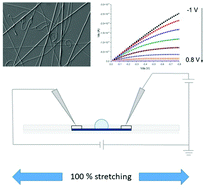Enhancing the performance of transparent and highly stretchable organic electrochemical transistors by acid treatment and copolymer blending of electrospun PEDOT:PSS fibers†
Abstract
Electrospun conductive nanofibers were obtained from a blend of poly(3,4-ethylenedioxythiophene):poly(styrene sulfonate) (PEDOT:PSS) and poly(ethylene glycol)–poly(propylene glycol)–poly(ethylene glycol) (PEG–PPG–PEG). The effect of the treatment with sulfuric acid (H2SO4) on the electromechanical performances of the fibers was investigated. Fibrillar mats treated with H2SO4 could be stretched up to 200% of their initial length with minimal loss (≈20%) of the current. Stretchable organic electrochemical transistors (OECTs) were fabricated by printing silver drain and source electrodes directly on the conductive electrospun fiber mats. The fabricated devices showed transistor behavior up to 100% strain and their transistor performance was maintained during 100 stretching/release cycles. The overall electronic and mechanical performances of the stretchable OECTs were better, even after stretching, than their counterparts that were prepared from spincoated thin films.



 Please wait while we load your content...
Please wait while we load your content...